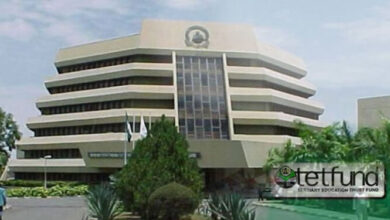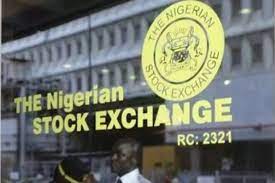
The Nigerian Exchange All Share Index (NGXASI) delivered a strong performance in the first half of 2025, closing at 119,978.57 points, representing a year-to-date gain of 16.57% from its opening level of 102,926.40 points. The market started Q1 on a positive note, recording cumulative growth of 2.66%, supported by moderate gains of 1.53% in January and 3.09% in February. However, it posted a mild correction in March, with a decline of 1.91%, as profit-taking activities dominated amid policy uncertainties.
Momentum accelerated in Q2 as investor confidence strengthened following favourable corporate earnings, clarifications on banks’ dividend payment status despite regulatory forbearance concerns, and renewed interest in consumer goods and growth stocks. This saw the NGXASI post a robust quarterly gain of 13.55%, driven by consistent monthly advances of 0.13% in April, 5.62% rally in May, and an impressive 7.37% jump in June, marking the market’s highest monthly gain this year.
The performance in H1 2025 shows renewed investor confidence and good positioning despite intermittent headwinds from monetary tightening and regulatory uncertainties. Analysts expect this positive momentum to slide into Q3, contingent on stable macroeconomic policy signals and favourable H1 2025 earnings results releases (see Table 1 below)
Table 1
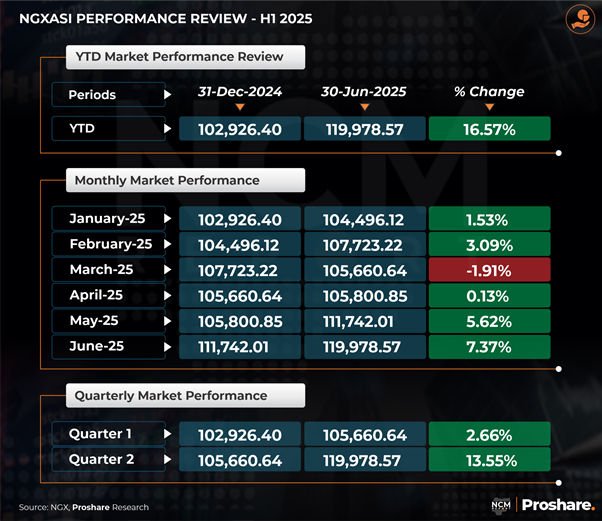
The Nigerian equity market closed the first half of 2025 with mixed sectoral performances, driven by macroeconomic policy adjustments, sector-specific news, and investor sentiment. The NGX Consumer Goods Index outperformed the sector with an impressive year-to-date return of 52.21%, driven by strong Q1 earnings releases and positive investor sentiment towards Fast-Moving Consumer Goods (FMCG) companies, which have demonstrated resilient pricing power amid inflationary pressures.
The NGX Growth Index also recorded a significant YTD growth of 45.13%, driven by a rally in select mid-cap stocks in June, rising by 20.63% alone as investors rotated into growth stocks ahead of H2 positioning. Similarly, the NGX Lotus Islamic Index gained 32.69% YTD, supported by strong performance from Shariah-compliant stocks, while the NGX Pension Index closed up 28.26% YTD, reflecting robust asset allocation flows from institutional investors (see table 2 below)
Investment
Table 2
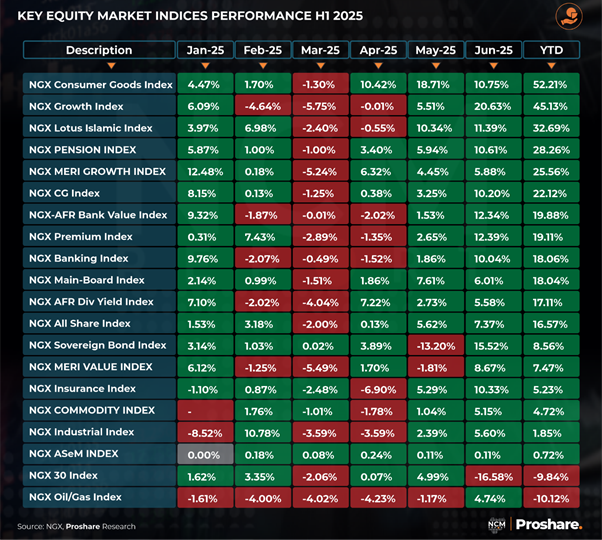
The banking sector index recorded a modest year-to-date gain of 18.06% despite experiencing a volatile first half of 2025. The index started the year on a strong note in January but came under pressure in February, March and April, as investors shifted focus towards the debt market. This shift was driven by the Debt Management Office’s (DMO) attractive sovereign offerings, including the remarkable oversubscription of the Federal Government of Nigeria’s (FGN) Series VII Sovereign Sukuk, which garnered total subscriptions of N2.21trn.
Investment
Additionally, the CBN’s forbearance loan circular temporarily suspended banks’ dividend payments, creating investor anxiety. However, the index recovered after several banks issued clarifications on their forbearance loan status and reaffirmed their dividend payment intentions, helping it close positively in June with a 10.04% monthly gain.
The NGX Oil and Gas Index was among the worst-performing indices, declining by 10.12% YTD, reflecting operational challenges within the sector, global oil price volatility, and investor reallocation away from energy stocks.
Analysts expect H2 performance to depend largely on the Central Bank’s policy trajectory, clarity on banking recapitalisation efforts, inflation trends, and global commodity price movements, while investors remain focused on dividend declarations and the H1 2025 earnings season to shape market sentiment.
Indices Comparability in H1 2025
The Proshare Index recorded a Year-to-Date (YTD) gain of 17.98% as of June 2025, positioning it slightly below the NGX Banking Index at 18.06% and NGX Premium Index at 19.11%, but outperforming the broader NGX All Share Index, which closed the half year with a 16.57% gain. The NGX Consumer Goods Index led sector performance with an impressive 52.21% growth, driven by a rally in FMCG stocks amid improved earnings and more favourable market sentiments.
Investment
The NGX Pension Index also delivered a YTD return of 28.26%, reflecting sustained accumulation by pension funds into stable blue-chip stocks. Meanwhile, the NGX Insurance Index saw a modest 5.23% gain, while the Oil and Gas Index remained negative, declining by 10.12%. Proshare index performance reflects restrained investor mindsets and portfolio rebalancing in relation to broader market volatility in H1 2025.
Table 3
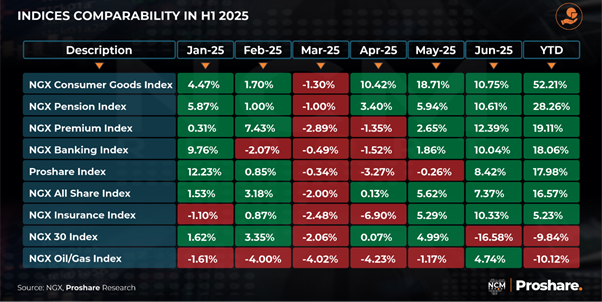
NASD OTC Market Maintained Strong Growth Momentum in Q1 2025
The NASD OTC Securities Exchange recorded a positive half-year performance in 2025, as the NASD Securities Index (NSI) closed at 3,347.43 points, marking a 11.48% year-to-date (YTD) gain from its opening level of 3,002.68 points. The first quarter was robust, with cumulative growth of 10.44% driven by sustained investor interest in unlisted securities and strategic positioning in high-dividend-paying firms. January saw a 3.87% gain, February accelerated with a 5.66% rise, and March closed Q1 on a positive note with a modest 0.63% increase.
However, Q2 performance was relatively muted, posting only a marginal 0.94% gain. This was due to a market correction in April (-1.06%) and May (-1.01%) as investors locked in profits following Q1 gains and reacted cautiously to monetary policy tightening and regulatory reviews that affected liquidity flows. The market regained momentum in June, closing the quarter with a 3.06% uptick amid renewed bargain hunting and portfolio rebalancing.
Investment
Analysts expect cautious optimism in the NASD OTC market in Q3 2025 as investors anticipate H1 earnings releases from key unlisted firms, which could drive renewed buying interest ( see Table 3 below)
Table 4

Investment
Fixed Income
The Nigerian Fixed Income market saw significant yield compression across both Nigerian Treasury Bills (NTBs) and Federal Government Bonds (FGBs) in H1 2025, driven by inflation moderation and a relatively stable FX window during the period. The NTB average benchmark yield declined from 25.53% on January 2, 2025, to 20.14% on June 30, 2025. The drop was driven by excess market liquidity, an increase in demand for short-term instruments, and investor expectations of a dovish monetary stance by the Central Bank of Nigeria (CBN). The FGN bond yields, which started the year at 19.16% on January 2, 2025, showed a gradual downward trend, settling at 18.07% on June 30, 2025, indicating investors’ preference for long-dated instruments.
Looking ahead to Q3 2025, the implementation of the Nigerian Tax Administration Act, 2025, could weigh on the domestic fixed income market, as well as potential monetary tightening by the CBN. However, improved foreign inflows could cause yields to stabilise as markets remain highly sensitive to macroeconomic events and policy developments (see chart 1 below).
Chart 1
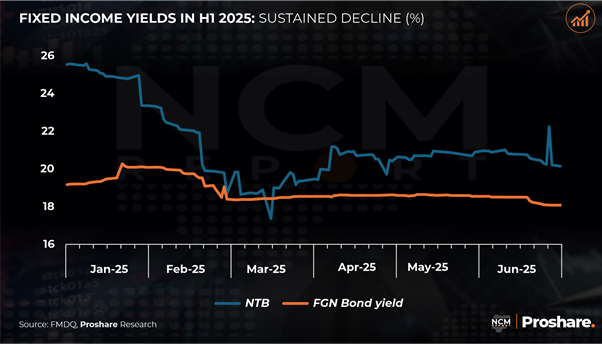
Investment
Mutual Funds Performance Review in H1 2025
Nigeria’s mutual funds market in the first half of 2025 was largely positive, with nine out of ten fund categories reporting gains. However, Bond/Fixed Income Funds faced a significant year-on-year (YoY) decline of 16.85%, reflecting challenges in the current economic landscape.
Real Estate Investment Trusts (REITs) saw noteworthy growth, rising by 202.99% YoY, driven by strong demand for real estate as an attractive investment option. Money Market Funds also performed well, registering a YoY growth of 142.42%, appealing to investors seeking safer investment choices amid uncertainty. Equity-Based Funds recorded a solid YoY growth of 122.45%, buoyed by upbeat corporate earnings and improving market sentiment (see chart below).
Chart 2

Investment
Nigerian Capital Market Size by Exchanges
The Nigerian capital market closed the first half of 2025 with a combined market size dominated by the FMDQ Debt Market, which accounted for 53% with a total size of N89.66trn. The NGX equities market followed, representing 45% with a market capitalisation of approximately N75.98trn, while the NASD OTC Securities Exchange accounted for 1% with a market size of N1.96trn.
H1 2025 saw a series of positive developments that reinforced investor confidence across exchanges. On the FMDQ, increased government and corporate bond issuances, coupled with high-yield attractive rates, drove turnover to new highs. In the equities market, the NGX All-Share Index gained over 16% YTD, supported by strong corporate earnings releases, strategic mergers and acquisitions, and banks’ clarifications on their forbearance loan status and dividend payment policies following the CBN circular. The NASD also recorded over 10% growth in its securities index as renewed investor interest flowed into unlisted securities with robust fundamentals.
According to Mr Olatunde Amolegbe, MD/CEO of Arthur Stevens Asset Management, who noted that “The market performed quite well as expected with ASI doing over 16% year to date gain. Most of the gains were driven by the consumer goods and telecommunications sectors. There was also a significant increase in the volume, value, and number of trades across the board. The stability in exchange rates and interest rates is encouraging investors to move towards riskier assets. We cannot discount the increased participation by foreign portfolio investors”
David Adonri, Highcap Securities, said that “The Equities Market appreciated by 16.6% in H1 2025. Q2 2025 contributed the lion’s share of 13.6% to the H1 performance. The highest gain occurred in the Consumer Goods sector, which appreciated by 52.21%, while the Oil and Gas sector declined by 10.12% in H1 2025. The Equities Market was propelled by recoveries in the Consumer Goods sector, driven by improvement in the fundamentals of companies that suffered exchange rate losses when the Naira was floated. The huge decline in prices of ARADEL and OANDO adversely affected the performance of the Oil/Gas sector”.
He further referred to the impact of the CBN circular, saying “when CBN released the circular on forbearance, it precipitated a backlash which caused a precipitous decline in the prices of bank stocks. After further clarifications, which reassured investors of the capacity of banks to continue to pay dividends”
Proshare analysts maintain a carefully optimistic outlook for the Nigerian capital market. The fixed income market is expected to remain attractive, given sustained elevated yields. Meanwhile, equities could see selective buying ahead of the H1 earnings season, particularly in the banking, consumer goods, and diversified industrial sectors. However, persistent macroeconomic uncertainties, regulatory tightening, and global market volatility remain downside risks (see chart 2 below)
Chart 3
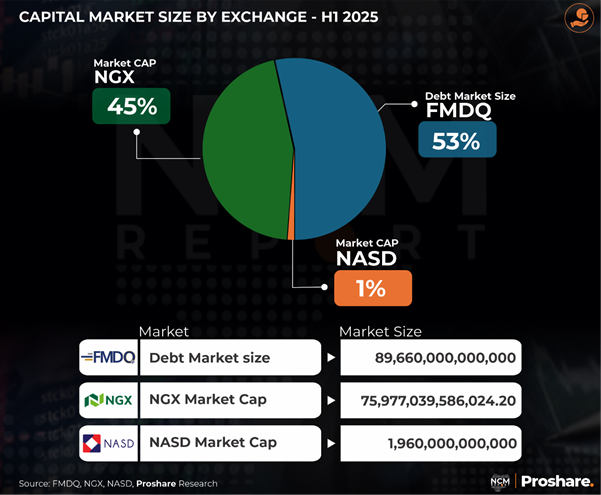
Local Commodities Market in H1 2025
AFEX Commodities Index (ACI) year-to-date (YTD) returns declined by -11.24%, indicating a decrease in the prices of certain staples. This was driven by increased supply from import fee waivers, harvest and hoarders’ sell-offs. In February 2025, AFEX enhanced its index methodologies to provide a more accurate performance analysis. Maize saw a rebound in March 2025, despite being a dominant influence, but lacked a convincing pull for a stronger ACI performance. The AEI declined by -9.03% year-to-date (YTD). AEI’s low performance, with Cocoa being the dominant commodity, is primarily attributed to fluctuations in global demand, weather conditions, and export dynamics.
The AFEX Commodity Index (ACI) recorded a sharp decline of 20.38% in H1 2025, closing at 60.58 points from 76.09 points as of June 30, 2025, indicating weaker market sentiment towards grains and other commodities amid subdued trading volumes and supply chain challenges. The AFEX AEI declined by 6.98% to close at 77.54 points, down from 83.36 points, due to decreased export demand, particularly for cocoa and sesame, as global prices remained under pressure during the period.
In contrast, LCFE’s Eko Gold delivered an impressive performance, surging by 46.23% to close at N130,000 per gram, buoyed by the global gold price rally driven by safe-haven demand amid economic uncertainties and persistent naira volatility. Meanwhile, Premium Eko Rice posted a marginal decline of 5.56% to N85,000 per bag from N90,000 in December 2024, as improved harvest and imports pressured local rice prices.
Analysts anticipate continued strength in gold prices, supported by global geopolitical risks and domestic currency weaknesses. However, ACI and AEI may remain muted if FX constraints for input imports and low export competitiveness persist, unless government interventions or new export contracts revive market confidence in Nigeria’s commodity value chain (see table 4 below)
Table 5
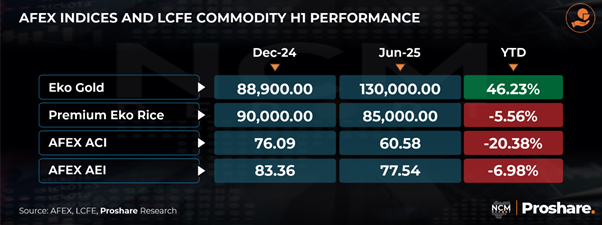
What to Expect from the Market in H2 2025
As market activities progress in the second half of 2025, investors and market stakeholders can stay informed about potential developments in the Nigerian Capital Market in H2 2025.
Below are the activities;
- The listing of Dangote Fertiliser Limited on NGX in H2 2025
- Additional shares listing from companies that have raised capital through Rights Issues.
- Proshare to release its CEO Remuneration and Online Trading reports in Q3 2025
- Most listed entities are expected to hold their Annual General Meetings (AGM) in H2 2025
- The CBN MPC Meeting is scheduled for July 21-22, September 22-23, and November 24-25, 2025. These meetings in H2 2025 will shape investors’ perceptions of the market.
- Issuers are expected to file their H1 2025 Financial Statements on the NGX portal after the 30-day grace period.
- The Nigerian Tax Reform Act, signed in the first half of 2025, is anticipated to stimulate economic growth, enhance revenue generation, and improve the business environment in the second half of 2025.
- Globally, we expect negotiations on US President Donald Trump’s tariffs to continue, with more deals possibly emerging. Meanwhile, inflationary pressures are expected to remain low, between 2% and 3%, as the full impact of the tariffs and ongoing global conflicts has yet to be felt, alongside fewer interest rate cuts worldwide
Adapted from the Proshare



